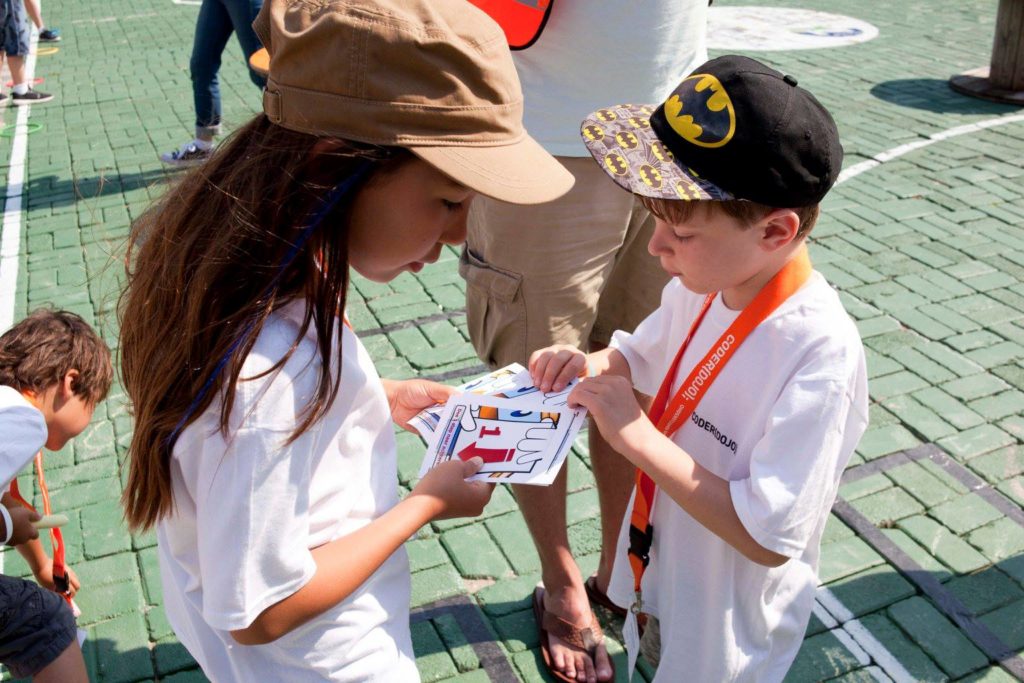
13th September 2018
Encouraging computational thinking offline with Unplugged activities
Unplugged activities are coding and coding-related activities that don’t require a computer. Lots of these are computational thinking tasks; learning to look at, break down, and design solutions to problems in the same way computer programmers do. These short activities are fantastic to introduce in your Dojo as icebreakers to help new Ninjas feel relaxed or as warm up activities to get everybody in the mood for some cool digital making! Longer ones can be good activities either for a change of pace or for Ninjas who may be too young to code on a computer. The following are some great unplugged activities that you can use. You can find more in the Champions Handbook which you can find here.
Dojos, such as Leiden Dojo in the Netherlands, which is championed by Chris, even ran an unplugged event, where the entire Dojo session was made up of outdoor unplugged activities!

Sorting Network
This exercise is great fun and can be done outside or inside with 6 people. You will need 3 different coloured pieces of chalk (for outside) or tape/string (for inside) and some items to sort! Books/names in alphabetical order is a good one, as is pages with numbers on them.
Set up our supercomputer on the ground with the chalk, tape or string like this diagram. If you have chalk, you can follow a similar colour pattern for the blue and orange lines as in the diagram, don’t worry if you don’t have it though.
Randomly position the 6 group members at the start of our supercomputer. Have them follow the lines (like the diagram) and each time they are in a purple box, they should compare their items. If their item is smaller or first in alphabetical order. They should follow the blue line or if you don’t have colours, they should follow the line that moves left. As they progress through the supercomputer, the items will be sorted. Double check everybody sorted correctly at the end and try some different items. If you have more than one ‘Sorting Network’ you can have a race to see which supercomputer is faster. Find out more about this activity here and see this video tutorial of a sorting network made outside with chalk. It is used to sort numbers, book titles and the pitch of bells!
Binary Bracelets
This is a great exercise to introduce binary to the Ninjas and they get to create something that they can bring home. All you need is this worksheet but you can use some thread or pipe cleaners and a combination of 2 colours in beads too. Start by introducing the word Binary to the Ninjas and reference that computers are made with lots of wires. Wires carry information through the machines in the form of electricity. There are only two pieces of information they can carry (the electricity being on or off). Binary is also used to store data, Hard Disk Drives store information using magnetic positive or negative and DVDs store information as either reflective and non-reflective. So binary is not just on/off.
The worksheet contains a Binary Decoder Key that matches capitol letters to a binary string. In these binary strings, the white boxes represent bits that are on and the black ones represent the bits that are off. Bit is just short for Binary Digit. Ask the Ninjas to colour the bits that they want to turn on so that their bracelet matches the pattern next to the first letter of their first name. Then they can cut out the bracelet and tape it around their wrist. If you are using beads, make sure to pick one colour for bits that are on and another for bits that are off. Find out more about this activity here. Below you can also see a video that contains some example bracelets.
Parity Bit Magic
This is a ‘magic’ trick you can show the group and all you need is 36 squares of card/paper (you can cut up a couple of A4 sheets for this). Leave one side of each card blank and put an X on the other side of each card. You can also put a ‘1’ and a ‘0’ on each side if you prefer. Ask one member of the group to lay out a ‘5×5’ grid on a table or the floor, randomly choosing what side each card is showing. Then announce that you will make the trick even harder for yourself by adding an extra row and column. When you are adding the extra card at the end of each row, make sure that the number of ‘1’s’ or ‘X’s’ is even. After the 5 rows, do the same for the, now 6 columns, again ensuring each column has an even number of of ‘1’s’ or ‘X’s’. If done correctly the final card should work for both the new row and column.
Now you can look away and ask one group member to flip any card they like, when you come back you can ‘guess’ the correct card by counting the ‘1’s’ or ‘X’s’ on each row and column. 1 of each should now be odd and the intersection of these is the flipped card. You can slowly reveal how you did it, mentioning that you added a parity bit. Parity bits are used to check for errors that often occur from signal interference. Find out more about this activity here and see this video tutorial showing the ‘trick’ in action.
For more back to Dojo resources see our forum post here!